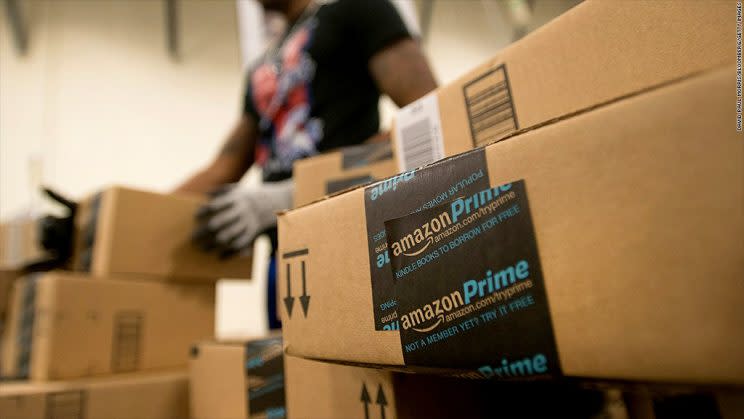Why Amazon decided to offer an even cheaper version of Prime
Now that more than 70% of households that earn more than $112,000 annually are Amazon Prime members, Amazon (AMZN) is focusing its attention on the rest of the country.
On Tuesday, the behemoth announced a 45% discount to its Prime membership for those on food stamps. Anyone who has an electronic benefit transfer (EBT) card can join Amazon Prime for $5.99 per month rather than $10.99.

Somewhere between 64 and 69 million households — or around 60% of all American families — are Prime members, according to Piper Jaffray estimates.
Though the company does not share total number of Prime customers, Amazon spokeswoman Julie Law confirmed it has “tens of millions of Prime members,” which it first disclosed this February. She added that the company added 20 million new members in 2016 alone.
But now it’s trying to tap into the rest of the country that might find Prime’s $99 annual fee or $10.99 per month financially burdensome.
Of course, the latest discount is not an altruistic move on Amazon’s part, as the company gains to benefit from tapping into the 45 million people who are eligible for the discounted membership.
How the $5.99 offering came to be
A little over a year ago in April 2016, Amazon Prime launched a monthly payment option in addition to its annual membership. The service costs $10.99 a month for all Prime offerings, including free two-day shipping on most items, unlimited streaming of movies and TV shows, and the Kindle book borrowing program (or $8.99 a month for Prime Video only).
Even though it’s ultimately more cost effective to opt into the annual model, most individuals think about budgets on a short-term basis (for better or for worse), said Law.
“This past year helped us identify that there’s a customer need for an affordable, monthly offering. Customers often budget monthly for video and music streaming services and find that it’s actually easier to sync and plan monthly rather than annually. Since then, our thinking around the monthly service has evolved. There’s great consumer need for this option,” she said.
Amazon investors like Tim Ghriskey, chief investment officer of Solaris Asset Management, said while he’s pleased that the move gives Amazon a perception of goodwill, it will ultimately help the company’s bottom line.
“The cost of Prime, while it’s certainly a material positive cash flow for the company, is something that they can afford to partially give away in exchange for more market share. The more people that get used to buying purely over the internet, the more long-term sales they’re going to have. Giving a little bit on the front end or a little bit annually to capture those sales is a good thing for the company,” said Ghriskey.
And, it turns out, there is actually a market opportunity. Sixty three percent of new subscribers are coming from the 4th and 5th quintile of income earners in the US, while penetration advances among 2nd and 3rd quintile earners has slowed, said Piper Jaffray analyst Michael Olson.
“If the 2nd-4th quintiles of US income earners ultimately adopted Prime at a comparable rate to the 5th quintile, it would add ~25% to total Prime households in the US,” he points out.

No car, no problem?
Beyond offering a lower Prime membership fee, this offering has larger implications for the low-income population it’s trying to attract.
“There’s a fundamental human need to have certain necessities that we all need to buy. The foundation of what Amazon offers is price, selection and convenience. Our hope is maybe not to be altruistic but a customer needs things and we’re trying to help them do it in the most convenient way possible for products that they’re already shopping for,” said Law.
The No. 1 gamechanger — not needing a vehicle to do your shopping.
“If you’re on government assistance, you might not even have a car to go shopping. If you go rurally, a big supermarket might be harder to get to. It’s a lot easier and more economical to have things delivered for free — and saving money on a car and gasoline,” said Ghriskey.
And for those who don’t live in doorman buildings, Amazon also offers self-service lockers where customers can pick up their packages. There are currently around 1,800 kiosks across 50 cities.
Just one piece of the puzzle
Despite the price discount for users, the glaring obstacle that users have to deal with is that users can’t actually use their EBT cards or food stamps to pay for their Prime memberships or delivery charges.
Amazon has also teamed up with the USDA in an effort to enable low-income individuals on government assistance to take advantage of the vast offerings and convenience of online shopping.
Amazon is among 10 retailers (which includes FreshDirect, ShopRite, Thrive Market and Wal-Mart), that are teaming up with the Food and Nutrition Service’s SNAP pilot. The program is expected to launch in early 2018 “after all system enhancements are complete.”
The pilot will take place across seven states in both rural and urban areas.
In another attempt to cater to the low-income consumer, the e-commerce giant launched Amazon Cash, a service that lets you add cash to an Amazon balance at 10,000 physical locations around the country, earlier this year. It’s part of the company’s attempt to target those who don’t have a debit or credit card to use on Amazon.
Citing AT&T’s Access, which offers low-cost wireline home internet service and Sprint’s prepaid Assurance Wireless phones, Law said Amazon is hoping to provide affordable solutions for those in need.
Yes, the wealthy American is already a captive audience for Amazon Prime, but now Amazon is striving to become the everything store to everyone.
